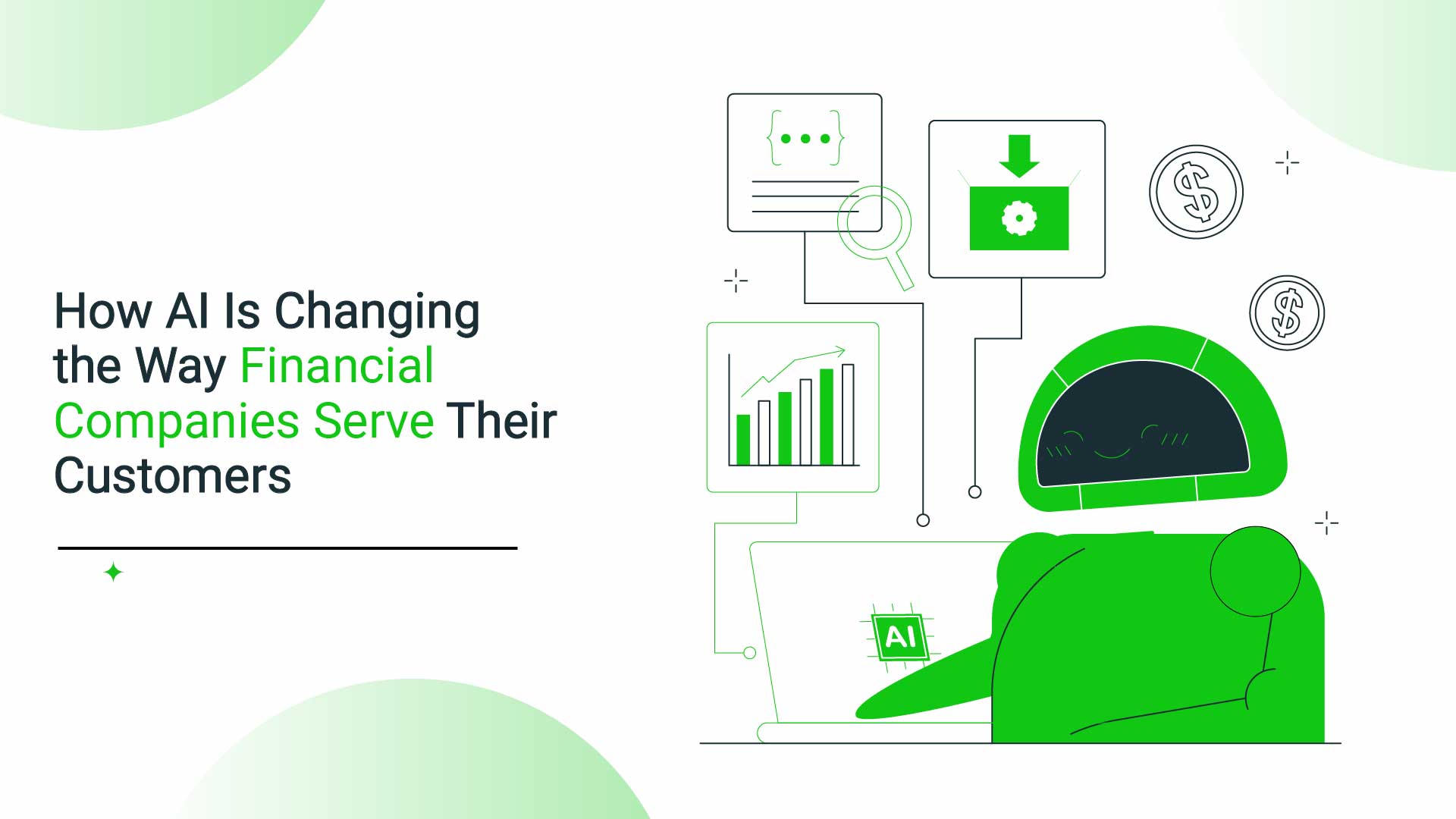How AI Is Changing the Way Financial Companies Serve Their Customers

Banking, insurance, and other financial companies are facing a wave of change driven by artificial intelligence. Adoption has already begun, but the pace is expected to accelerate quickly. The question is whether these companies are ready.
A Boston Consulting Group survey found that only one in four banks is prepared for widespread use of AI. At the same time, McKinsey reports that a regional bank increased productivity by 40 percent after introducing generative AI tools. The potential is enormous, but most organizations are only beginning to tap it.
Customers are also driving the shift. At CaixaBank in Spain, more than 12 million people log in to digital channels every day. Nearly three-quarters of customer experience teams across financial services already use AI in some form, and close to 70 percent of executives expect these tools to boost revenue.
What customers expect
Customers no longer accept one-size-fits-all financial products. Artificial intelligence makes it possible to create real-time interactions tailored to each person, a shift that is already underway. The Financial Times notes that the next stage of digitalization will bring services designed around individual needs rather than mass-market averages.
Accenture’s Global Banking Consumer Study highlights four factors that turn satisfied customers into loyal advocates: trust, consistency, delight, and reward. In practice, this means financial institutions must demonstrate that they remember customer preferences, provide smooth service across different channels, and offer personalized rewards.
These expectations are becoming the standard. In Europe, the share of citizens using online banking rose from 42 percent to 67 percent in just one year. As digital adoption accelerates, banks and insurers will need AI to meet rising demands for personalized, seamless, and reliable service.
Key AI use cases
Artificial intelligence is giving financial institutions the ability to understand customers at a much deeper level. By analyzing large volumes of data, AI and machine learning can uncover individual preferences and tailor services to each person. Usage-based insurance, for example, adjusts coverage and pricing in real time based on behavior. Predictive analytics also drives personalized marketing, suggesting the next best action for each customer and helping companies strengthen loyalty over time.
Conversational tools are another area where AI is changing the customer experience. Modern chatbots and voice systems now go far beyond answering simple questions. Bradesco, one of Latin America’s largest banks, uses advanced AI to provide concierge services, freeing employee time and reducing lead times. CaixaBank’s virtual assistant has become the company’s busiest support channel, with four million users. Morgan Stanley has taken this even further by using generative AI to summarize meeting notes and send follow-up emails, showing how conversational systems can also support employees behind the scenes.
Fraud detection and risk management have also advanced through AI. In the U.S., check fraud increased nearly 400 percent from the start of the pandemic through early 2024. To counter this, the U.S. Treasury implemented an AI system that recovered $375 million in fraudulent proceeds. Visa now assigns real-time risk scores to transactions, blocking many before they go through.
Banks are also using AI to strengthen compliance, with generative models comparing regulations, flagging gaps, and recommending policy updates. IBM estimates that companies using AI for fraud prevention and data security save an average of $2.2 million compared with those that rely only on traditional systems.
Challenges on the path to AI adoption
The advantages of artificial intelligence are clear, but the road to adoption comes with obstacles. Many banks and insurers are still running isolated pilot projects that rarely scale across the business. This slow pace delays results and risks losing customers to digital-first competitors.
Data quality is a major barrier. AI depends on clean, comprehensive information, yet many organizations keep customer records in separate systems or rely on outdated formats. When data is messy or locked in silos, it cannot support real-time personalization or automation. Companies that want to move forward need to audit their data, identify reliable sources, eliminate duplicates, and build modern platforms with real-time pipelines and quality checks.
Regulation and ethics present another challenge. Financial services operate under strict and constantly evolving rules. AI can add risks if models are opaque, biased, or careless with personal information. Without strong safeguards, even well-intentioned tools can erode customer trust. Addressing this requires clear governance, documentation of how models work, privacy built into design, and humans in the loop for sensitive decisions. Regular reviews and compliance checks keep systems accountable once they are in use.
Together, these challenges underline that adopting AI is not simply about installing new tools. It requires disciplined attention to strategy, data, and ethics to make sure the technology delivers value without undermining trust.
A roadmap for successful AI adoption
Successful adoption of artificial intelligence in financial services depends on three essentials: aligning projects with business goals, building a reliable technology foundation, and preparing people to use the tools effectively.
The first step is to focus on customer journeys that matter most, such as onboarding, service requests, or fraud claims. For each one, define the problem, set a clear outcome, choose the right metrics, and assign ownership. Starting with a small, visible win within a few months builds momentum and proves the value of further investment.
Next comes the technology layer. Companies need secure data platforms, real-time feeds, and open interfaces that connect different systems. Decisions about what to build internally and what to buy from outside vendors should be made early. Strong guardrails – including privacy by design, human oversight, and thorough testing – are essential before any launch. Continuous monitoring and regular audits keep systems accountable once they are in use.
The final step is talent development and scaling. Pilot projects must evolve into full-scale products, supported by standard processes and safe testing environments. Training should extend beyond technology teams to risk managers, product developers, and frontline staff who use AI in their daily work. Tracking results and sharing successes across the organization helps refine best practices and ensures ongoing improvement.
Like building a new metro line, AI adoption requires careful planning, strong infrastructure, and well-trained crews. Each successful project adds another stop to the system, expanding its reach and reliability over time.
Final thoughts
Artificial intelligence is no longer optional in financial services. Companies that use it well can personalize products, provide faster support, anticipate customer needs, and detect fraud more quickly. The results are clear: lower costs, safer accounts, and more satisfied customers.
Yet most organizations remain stuck in pilot programs rather than committing to full-scale adoption. The winners will be those that tie AI directly to business goals, invest in clean and accessible data, and build systems with strong safeguards for privacy and fairness. Just as important, they will prepare their workforce to use these tools confidently and responsibly.
Early adopters are already showing that a focused approach creates real advantages. Those who delay risk falling behind as digital-first competitors set higher expectations. In this new landscape, acting with purpose and discipline is the key to building trust and long-term success.
- About Olena Domanska
- About Avenga
Olena Domanska, Ph.D. Head of AI at Avenga
Avenga is an international consultancy and technology solutions partner creating unique solutions that solve complex business and societal challenges. With 6000+ specialists they operate globally and provide a full spectrum of services, including business and tech advisory, enterprise solutions, CX, UX and UI design, managed services, product development, and software development. Avenga serve a wide range of industries, from telco and satellite operators to banking, manufacturing, automotive, mobility, and life sciences – driving their AI-first transformation. Our AI capabilities are embedded across all offerings, enabling organizations to drive intelligent automation, accelerate decision-making, and deliver highly personalized user experiences. Avenga is a part of the technology pillar within the family owned KKCG Group.


